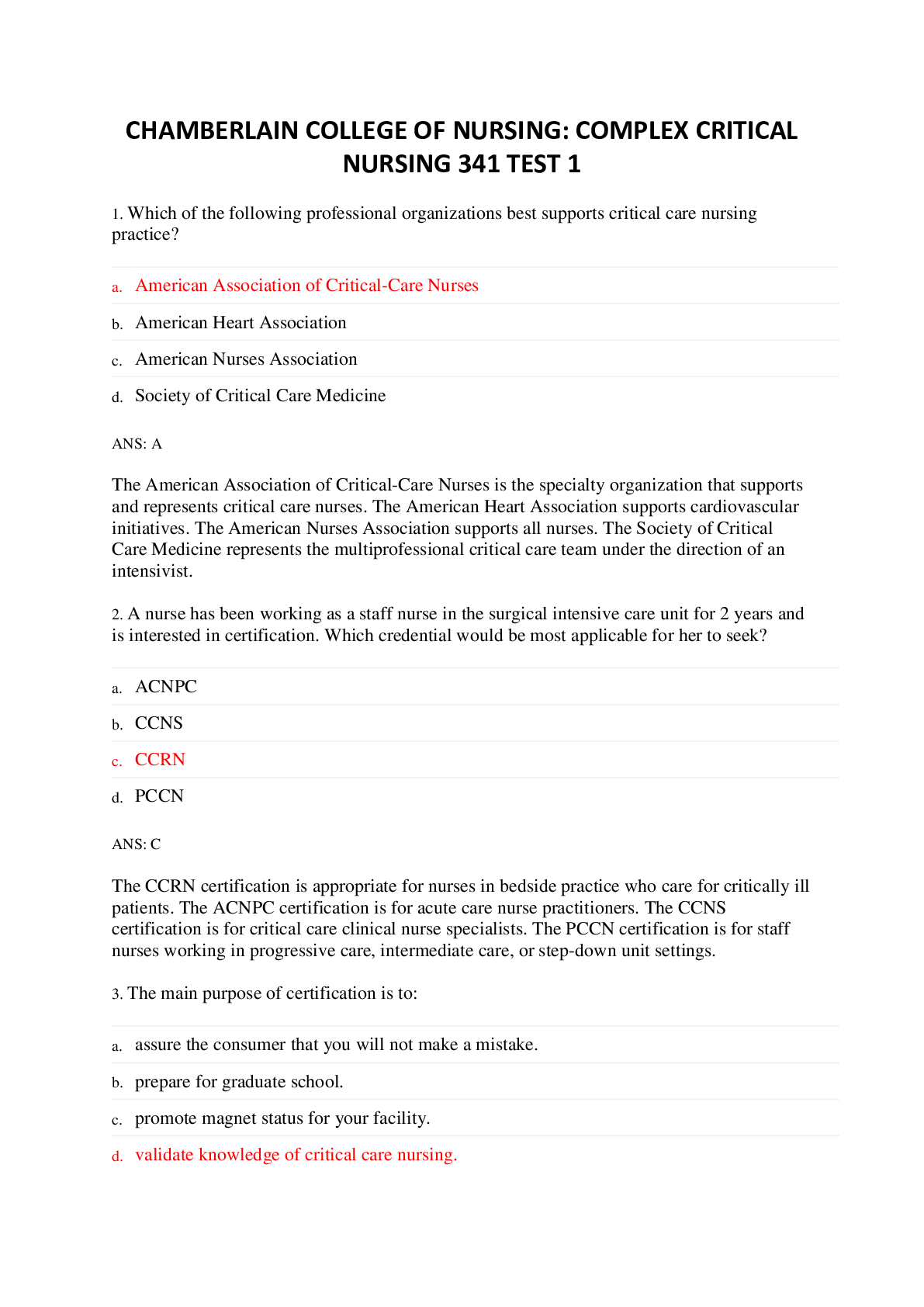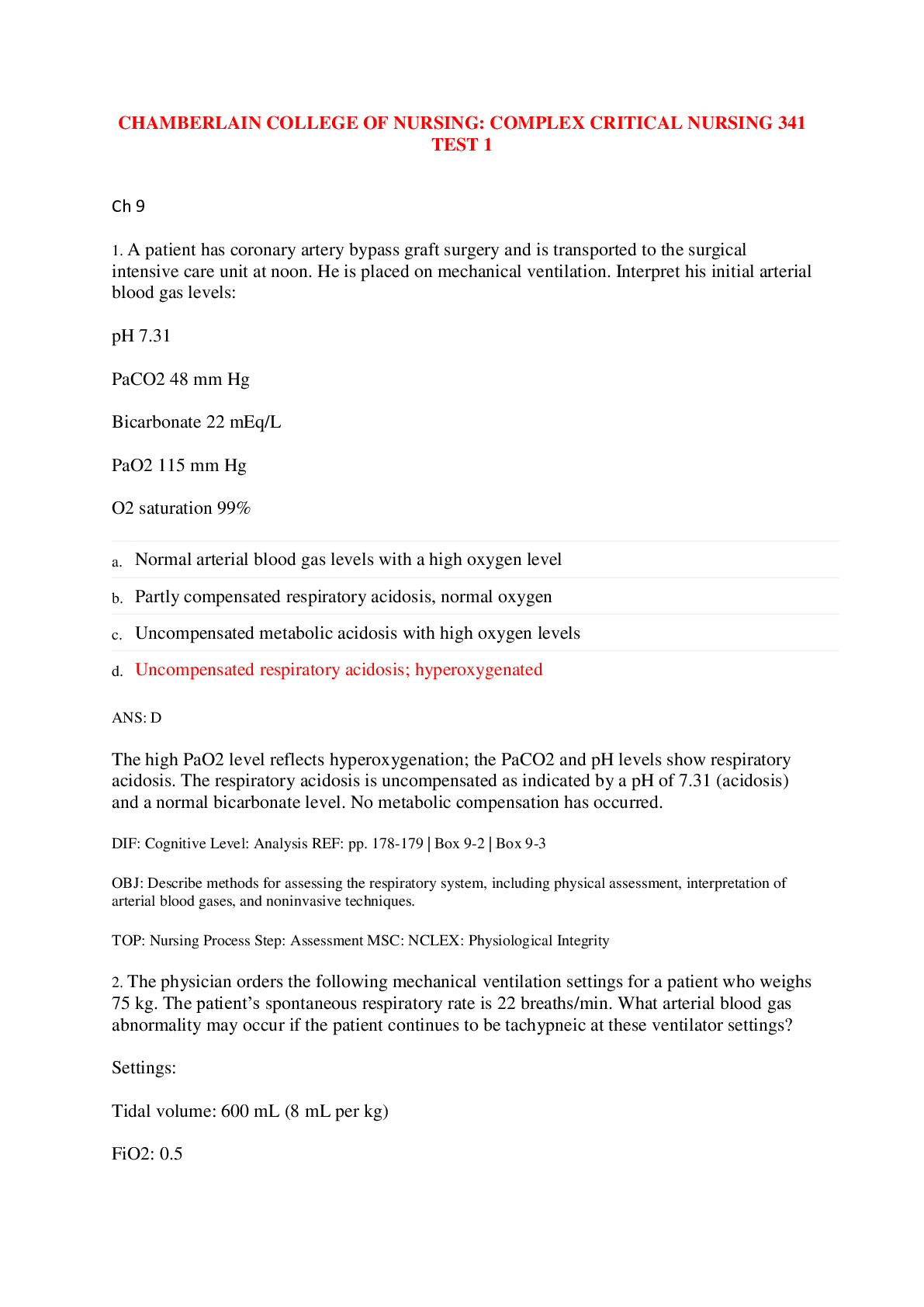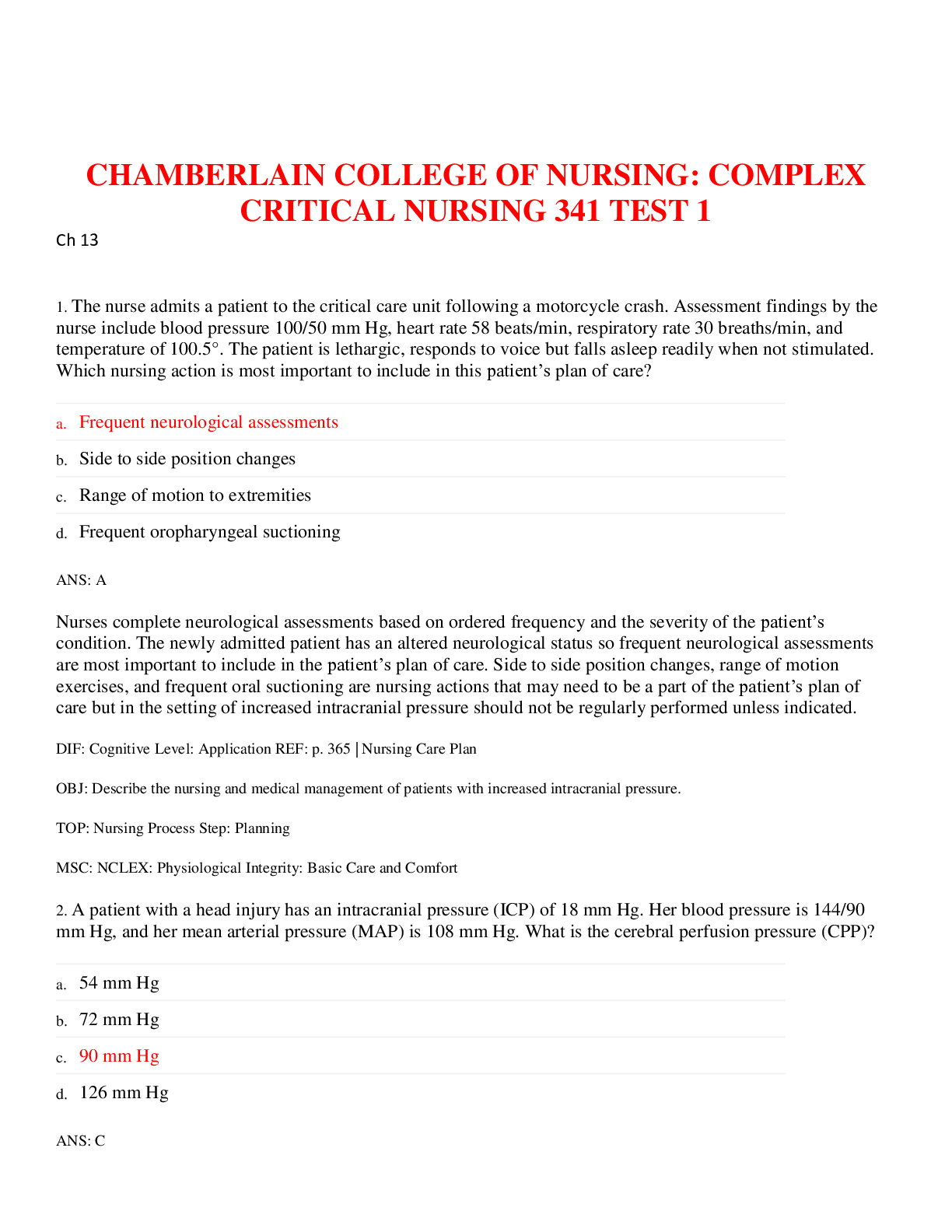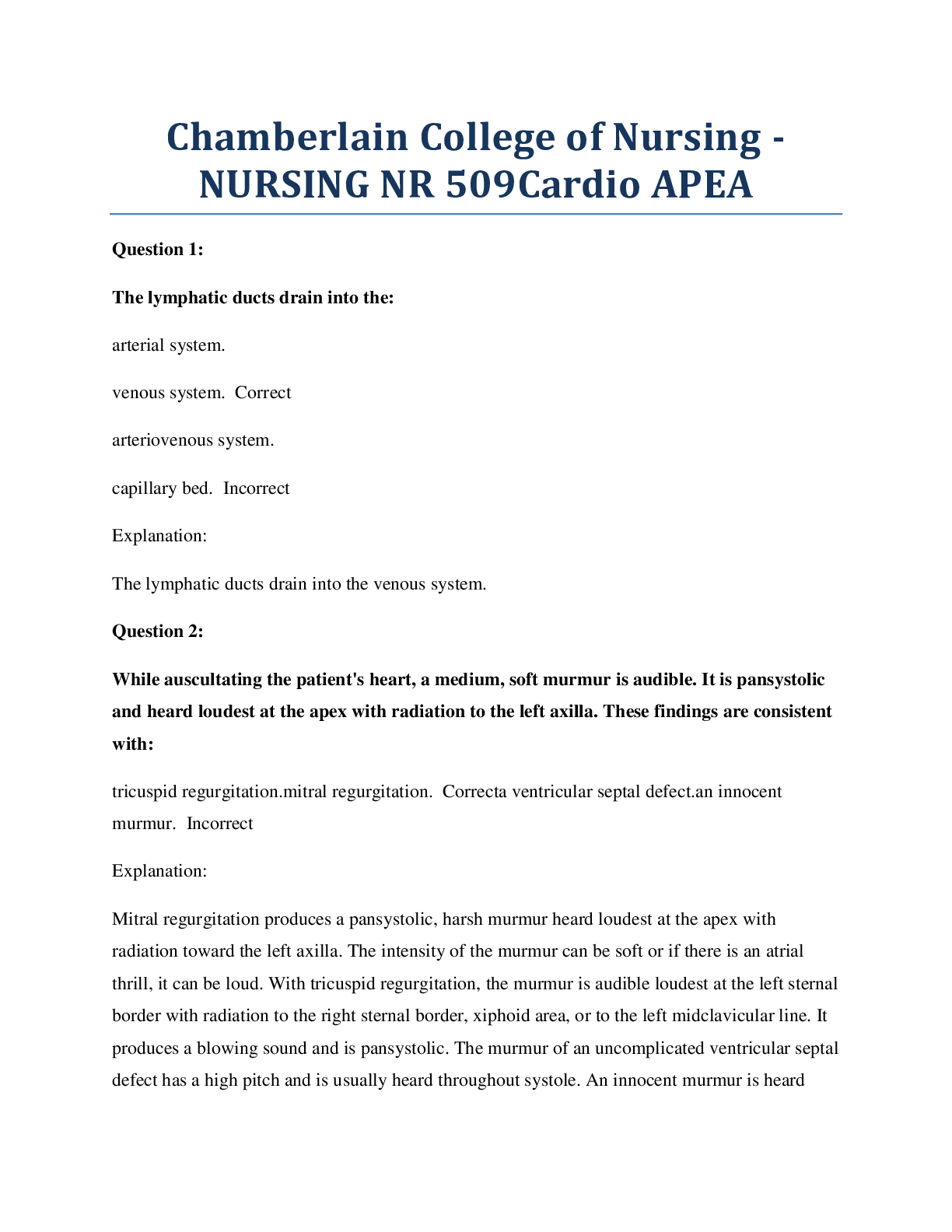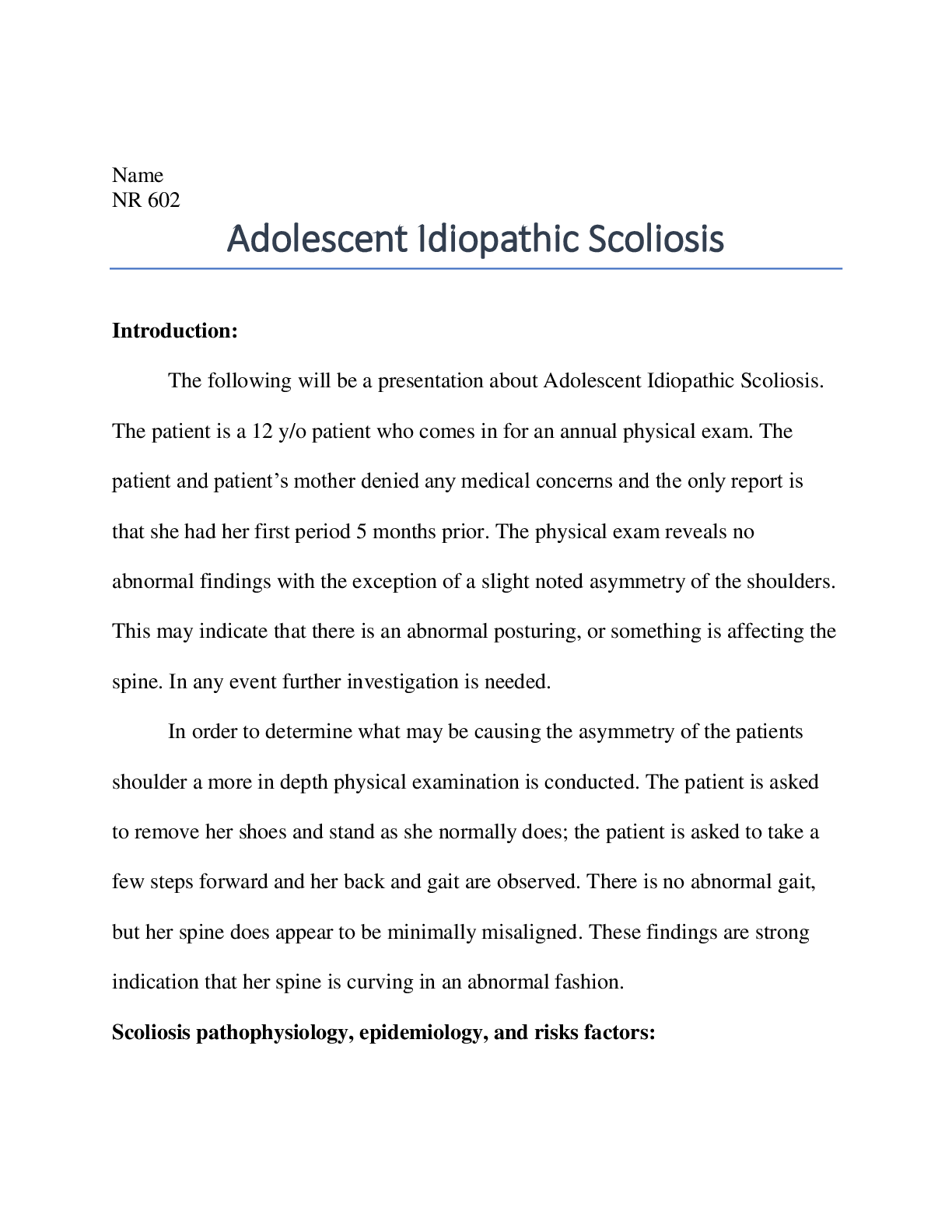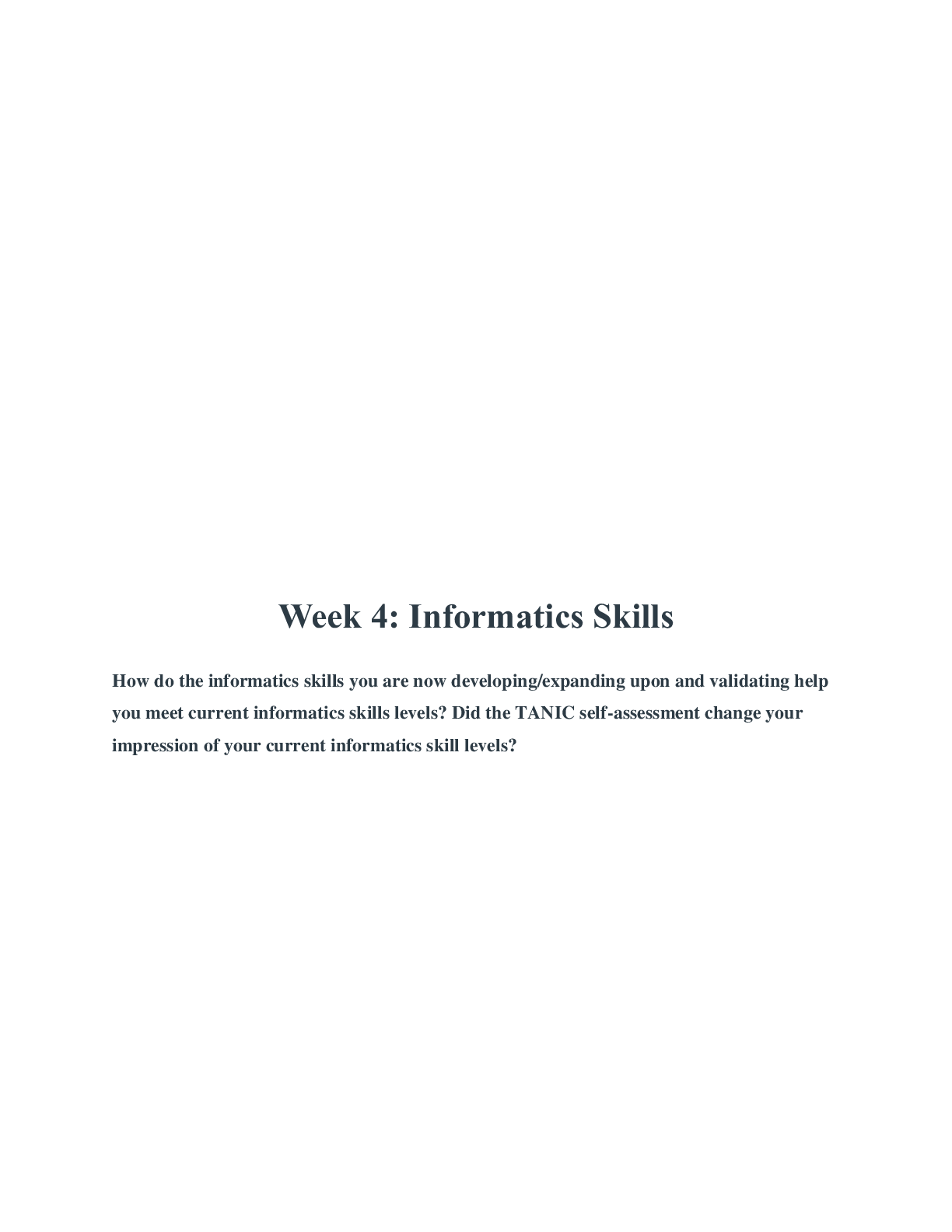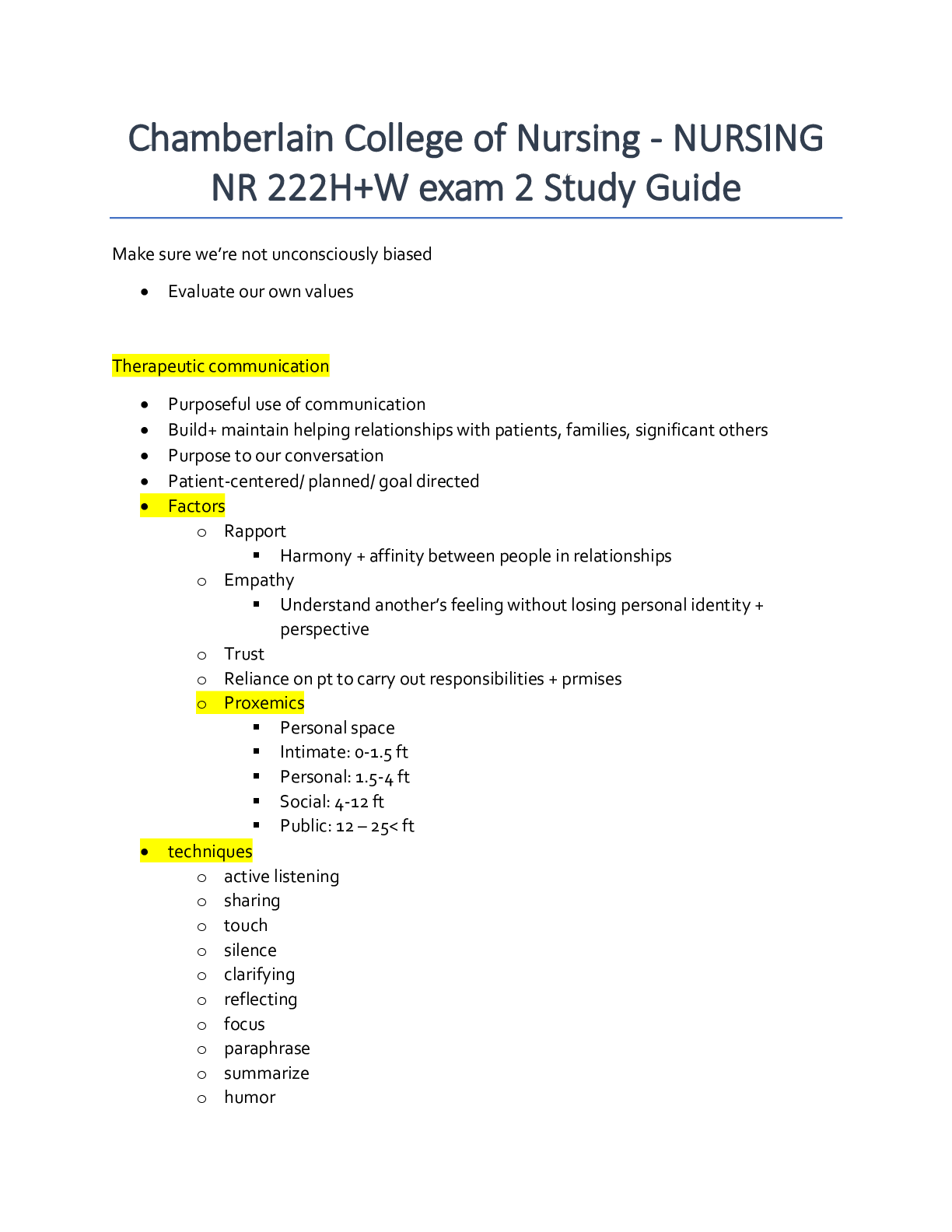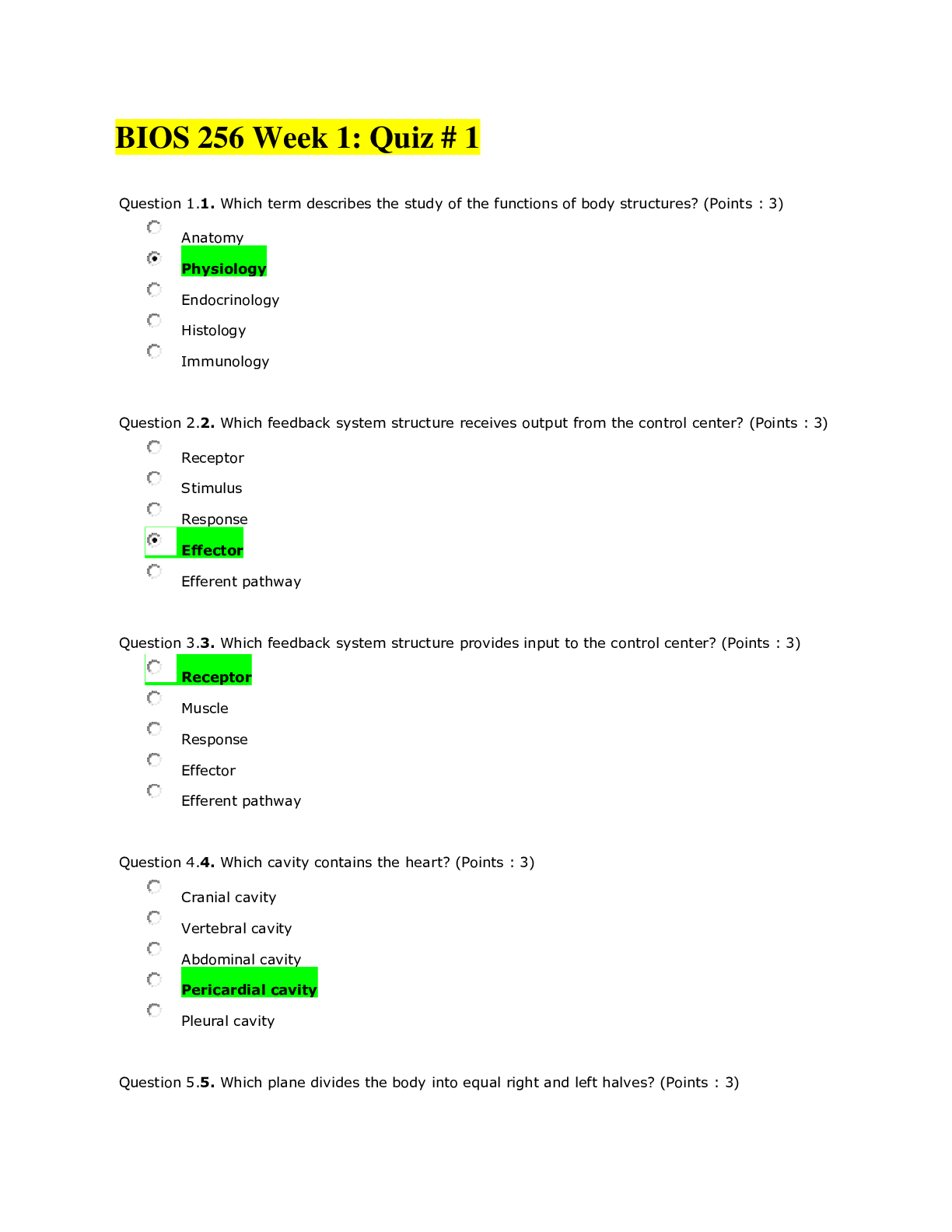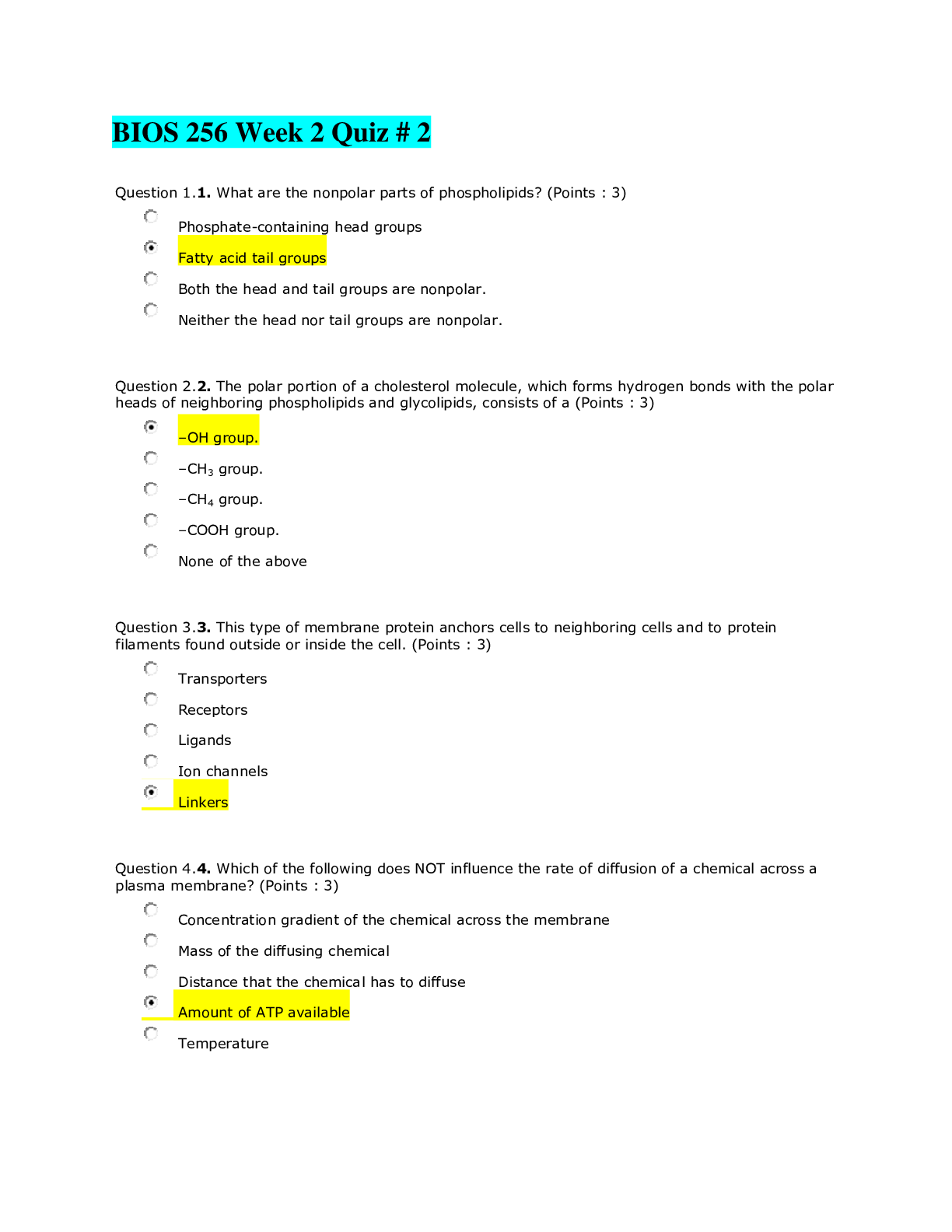*NURSING > QUESTIONS & ANSWERS > Allied Nursing: Care of the Patient with an Endocrine Disorder OBQ. ALL CORRECT ANSWERS: CHAMBERLAIN (All)
Allied Nursing: Care of the Patient with an Endocrine Disorder OBQ. ALL CORRECT ANSWERS: CHAMBERLAIN COLLEGE OF NURSING
Document Content and Description Below
Care of the Patient with an Endocrine Disorder OBQ 1. Select all that apply: Which of the following are true of endocrine glands: a. They are ductless b. They secrete through a series of ducts c. ... They release secretions directly into the bloodstream d. Their secretions are protective and functional 2. Hormones are secreted by the endocrine system. They work closely with which of the following systems? a. Reproductive System b. Circulatory System c. Integumentary System d. Nervous System e. Cardiovascular System 3. https://www.youtube.com/watch?v=Iz0Q9nTZCw4 The concentration of hormones in the bloodstream is regulated by: a. Production of receptor antagonists b. Indirect growth-promoting effects c. Nutritional signals to the endocrine gland d. Positive and negative feedback loops 4. The Pituitary Gland is known as the “master gland.” It is divided into two segments: the anterior pituitary (adenohypophysis) and the posterior pituitary (neurohypophysis). Each segment produces specialized hormones. Match the hormone to the gland that secretes it: Growth Hormone (GH) Anterior Pituitary Adrenocorticotropic Hormone (ACTH) Anterior Pituitary Oxytocin Posterior Pituitary Thyroid-stimulating hormone (TSH) Anterior Pituitary Antidiuretic hormone (ADH) Posterior Pituitary Follicle-Stimulating Hormone Anterior Pituitary Luteinizing hormone (LH) Anterior Pituitary Prolactin (PRL) Anterior Pituitary 5. Which hormone increases basal metabolic rate in the body? a. Thyroid hormone b. Parathyroid hormone c. Secretin d. Glucagon 6. Which of the following is not a function regulated by thyroid hormones? a. Growth and Development b. Metabolism c. Activity of the nervous system d. Increases calcium serum levels 7. The primary role of the parathyroid gland is: a. To maintain metabolic homeostasis b. To regulate serum calcium levels c. To send hormonal signals to other endocrine organs d. To receive hormonal signals from the hypothalamus 8. The adrenal cortex is divided into three separate layers. Match the hormone secreted by each zone: Zona Glomerulosa Mineralocorticoids (Aldosterone) Zona Fasciculata Glucocorticoids (Cortisol) Zona Reticularis Sex Hormones (Androgens and Estrogens) 9. Which of the following are typical body reactions created by the body during a “flight or fight” response? Select all that apply: a. Increase in Heart Rate b. Frequent urination c. Increase in Blood Pressure d. Release of glucose reserves e. Digestion Increases f. Blood vessels constrict 10. https://www.youtube.com/watch?v=8dgoeYPoE-0 After consuming a banana split, which hormones would be expected to increase? a. Prolactin b. Glucagon c. Insulin d. Parathyroid Hormone 11. True or False: Beta Cells secrete glucagon in response to decreased levels of glucose in the blood. a. True b. False 12. Which of the following hormones would be expected to increase if you were studying all day for a test and skipped breakfast and lunch? a. Glucagon b. Growth Hormone c. Calcitonin d. Insulin 13. A gonad, sex gland is a mixed gland that produces the sex cells and sex hormones of an organism. In the female of the reproductive cells are the egg cells, and in the male the reproductive cells are the sperm. The male gonad, the testicle, produces sperm. The female gonad, the ovary, produces egg cells. The gonads are controlled by luteinizing hormone and follicle-stimulating hormone, produced and secreted by gonadotropins in the anterior pituitary gland. This secretion is regulated by gonadotropin-releasing hormone produced in the hypothalamus. Select the hormones secreted by the ovaries. Select all that apply: a. Estrogen b. Testosterone c. Aldosterone d. Progesterone 14. Select all that apply: Testosterone is responsible for the development of? a. Axillary, pubic, and facial hair b. Maturation of the reproductive organs c. Deepening of the voice d. Development of muscles and bone mass e. Sperm formation 15. The thymus gland plays a role in the endocrine and what other system? a. Cardiovascular b. Respiratory c. Immune d. Reproductive 16. The pineal gland secretes ____________ which affects sleep, mood, and has an impact on menstrual cycles. a. ADH b. Oxytocin c. Melatonin d. ACTH e. Growth Hormone https://www.youtube.com/watch?v=5V0oRu0wvmw Overview Symptoms 17. Which of the following is often the first sign of acromegaly? a. Deepened Voice b. Enlarged Tongue c. Visual Disturbances d. Fatigue and Muscles weakness 18. A patient suspected of having acromegaly has an elevated plasma growth hormone level. In acromegaly, the nurse would also expect the patient's diagnostic results to include a. hyperinsulinemia b. a plasma glucose of less than 70 c. decreased growth hormone levels with an oral glucose challenge test d. insulin-like growth-factor of more than 300 19. The goal of treatment with medication is to suppress GH secretion. Which of the following medications would be prescribed to a patient with acromegaly? a. octreotide b. fludrocortisone c. levothyroxine d. mitotane https://www.youtube.com/watch?v=22k3BXDY0-4 20. Which of the following would be elevated in a patient with gigantism? a. Androgens b. Insulin c. Growth hormone (GH) d. ACTH 21. The nurse would question a prescription for somatropin (Genotropin) in a patient with which condition? a. Dwarfism b. Acromegaly c. Growth failure d. Hypopituitarism https://www.youtube.com/watch?v=0NHT8ERUBo0 22. (Essay) A patient arrives to the ER and is unable to give you a health history due to altered mental status. The family reports the patient has gained over 10 lbs in 1 week and says it is mainly “water” weight. In addition, they report the patient hasn’t been able to urinate or eat within the past week as well and was recently diagnosed with small cell lung cancer. On assessment, you note the patient’s HR is 115 and BP 180/92. Patient sodium level is 90. Which of the following conditions do you suspect the patient is most likely presenting with and what are the signs and symptoms that lead you to believe this? In the scenario above what drug do you anticipate the patient will be started on per doctor’s order and why? You are developing a care plan for a patient with SIADH. Which of the following would be a potential nursing diagnosis for this patient? https://www.youtube.com/watch?v=XcXjo4hLnK8 23. Which of the following signs and symptoms is NOT expected with Diabetes Insipidus? a. Polyuria b. Polydipsia c. Polyphagia d. Extreme thirst 24. A patient with a mild case of diabetes insipidus is started on Diabinese. What would you include in your patient teaching with this patient? a. Signs and symptoms of hypoglycemia b. Restricting foods containing caffeine c. Taking the medication on an empty stomach d. Drinking 16 oz of water when taking the medication 25. A patient is brought to the emergency department and is not able to give you a health history due to altered mental status. The family reports the patient has gained over 12 lbs in 1 week and says it is mainly “water” weight. In addition, they report the patient hasn’t been able to urinate or eat within the past week as well and was recently diagnosed with small cell lung cancer. On assessment, you note the patient’s HR is 115 and BP 180/92. Patient sodium level is 90. Which of the following conditions do you suspect the patient is most likely presenting with? a. SIADH b. Diabetes Insipidus c. Addison's Disease d. Fluid Volume Deficient 26. In the scenario above what drug do you expect the patient will be started on by the doctor’s order? ___________________ 27. You are formulating a care plan for a patient with SIADH. Which of the following would be a potential nursing diagnosis for this patient? a. Fluid volume overload b. Fluid volume deficient c. Acute pain d. Impaired skin integrity 28. The anti-diuretic hormone is __________ in Diabetes Insipidus and _________ in SIADH. a. high, low b. absent, absent c. low, high d. low, low 29. A female client is admitted for treatment of SIADH. Which nursing intervention is appropriate? a. Infusing I.V. fluids rapidly as ordered b. Encouraging increased oral intake c. Restricting fluids d. Administering glucose-containing I.V. fluids as ordered 30. What gland PRODUCES anti-diuretic hormone in the body? __________________________ What gland SECRETES anti-diuretic hormone in the body? __________________________ https://www.youtube.com/watch?v=5UTXFU86wK4 https://www.youtube.com/watch?v=QvsjUOqax8U 31. T or F Hyperthyroidism is also called Graves’ disease. True 32. Fill in the blank: The ______________ produces TRH (Thyrotropin-Releasing Hormone) which causes the anterior pituitary gland to produce _______________ which in turn causes the thyroid gland to release _______ and _______. 33. A patient states’ they do not have enough iodine in their diet. What condition are they most susceptible to? a. Pheochromocytoma b. Hyperthyroidism c. Thyroid Storm d. Hypothyroidism 34. A patient is being discharged from the hospital for treatment of hypothyroidism. Which medication is most commonly prescribed for this condition by the doctor? a. Tapazole b. PTU (Propylthiouracil) c. Synthroid d. Inderal 35. You are teaching a patient who is going home on Synthroid. Which statement by the patient requires you to re-educate the patient about this medication? a. “I will take this medication at bedtime with a snack.” b. “I will never stop taking the medication abruptly.” c. “If I have palpitations, chest pain, intolerance to heat, or feel restless, I will notify the doctor.” d. “I will not take this medication at the same time I take my Carafate.” 36. A patient is admitted with complaints of palpations, excessive sweating, and unable to tolerate heat. In addition, the patient voices concern about how her appearance has changed over the past year. The patient presents with protruding eyeballs and pretibial myxedema on the legs and feet. Which of the following is the likely cause of the patient's signs and symptoms? a. Thyroiditis b. Deficiency of iodine consumption c. Grave's Disease d. Hypothyroidism 37. Which of the following are treatment options for hyperthyroidism? Select all that apply a. Thyroidectomy b. Methimazole c. Liothyronine Sodium "Cytomel" d. Radioactive Iodine e. Synthroid f. Tapazole g. Inderal 38. When assessing a patient experiencing a thyroid storm, which of the following would you find? a. increased body temperature, decreased pulse, and increased blood pressure b. increased body temperature, increased pulse, and increased blood pressure c. increased body temperature, decreased pulse, and decreased blood pressure d. increased body temperature, increased pulse, and decreased blood pressure 39. What observation after a thyroidectomy would indicate laryngeal nerve damage? a. hoarseness of voice b. difficulty in swallowing c. tetany d. fever 40. An incoherent male patient with a history of hypothyroidism is brought to the emergency department via ambulance. Physical and laboratory findings reveal severe hypothyroidism. Nurse Isabella prepares to take emergency action to prevent the potential complication of: a. Thyroid storm. b. Cretinism. c. Myxedema coma. d. Hashimoto's thyroiditis. 41. Nurse Joe would assess a male client for Chvostek's sign and Trousseau's sign, during the first 72 hours after thyroidectomy surgery, because they indicate which of the following? a. Hypocalcemia b. Hypercalcemia c. Hypokalemia d. Hyperkalemia 42. The doctor orders levothyroxine (Synthroid), 25 mcg P.O. daily for Ms. Sommer’s who was diagnosed with hypothyroidism (myxedema). Which finding should nurse Jenny recognize as an adverse drug effect? a. Dysuria b. Leg cramps c. Tachycardia d. Blurred vision 43. Mr. Brown is diagnosed with hyperthyroidism and is prescribed propylthiouracil (PTU). The nurse will monitor him for: a. gingival hyperplasia and lycopenemia. b. dyspnea and a dry cough. c. blurred vision and nystagmus. d. fever and sore throat. https://www.youtube.com/watch?v=JiS0oGqUck0 44. https://www.youtube.com/watch?v=ewV9xHCg9vM&list=PLipT5KAom4IvIRdATKWfx-w8ssUQYYd4B&index=1 45. Select all that apply: Which of the following are risk factors for thyroid cancer? a. Age b. Low iodine diet c. Radiation exposure d. Activity level e. Hypocalcemia f. Gender https://www.youtube.com/watch?v=uq8jB79j9dE https://www.youtube.com/watch?v=tLzYQQKr4vw 46. Mrs. Keaton is recovering from a thyroidectomy and begins to complain of tingling and numbness in her face, toes, and fingers. Which of the following findings below requires immediate attention? a. A. Ca+ level: 6 mg/dL b. B. Na+ level: 145 mg/dL c. C. K+ level: 3.5 mg/dL d. D. Phosphate level: 4.3 mg/dL 47. Which of the following clients would be most susceptible to hypoparathyroidism? a. A 75 year-old female who is diabetic and takes Os-Cal daily. b. A 59 year-old male with a Mg+ level of 0.9 mg/dL. c. A 85 year-old female complaining of flank pain and constipation. d. A 19 year-old male with a Ca+ level of 8.9 mg/dL. 48. The doctor orders Calcium Gluconate IV as treatment for a patient with hypoparathyroidism. The patient’s calcium level is 5 mg/dL. Which of the following findings causes you to question this order? a. A. The patient is taking Digoxin. b. B. The patient complains of muscle cramping and numbness in the face. c. C. The patient is taking Aluminum Carbonate. d. D. The patient’s phosphate level is 7 mg/dL. 49. Joe is about to be discharged and you are providing teaching to the patient. He is prescribed calcium supplements with vitamin D for treatment of hypoparathyroidism. Which of the following statements by Joe requires you to re-educate the patient on how they should take this medication? a. A. “I will also make sure I eat foods rich in calcium, such as dairy and green leafy vegetables while I’m taking this medication.” b. B. “A side effect of this medication is constipation. Therefore, I should drink plenty of fluids.” c. C. “I will take my calcium supplements in the morning when I take my Synthroid.” d. D. All the statements above are correctly stated by the patient. 50. Rebecca is currently recovering from a parathyroidectomy. Which of the following findings causes concern and requires nursing intervention? a. A. The patient is in Semi-Fowler's position. b. B. The patient's calcium level is 8.9 mg/dL. c. C. The patient’s voice is hoarse. d. D. The patient is drowsy but arouses to name. 51. In a patient with hyperparathyroidism, which signs and symptoms would not be found? Select all that apply: a. Calcium level 6 mg/dL b. Bone fracture c. Positive Trousseau’s Sign d. Tingling and numbness of lips and fingers e. Calcium level of 15 mg/dL f. Phosphate level 1.2 g. Renal calculi 52. Mr. Green is a patient that has been hospitalized with hypoparathyroidism. He is very hungry and is about to order something to eat. Which of the following food selections is best for this patient based on their dietary needs at this time? a. Baked chicken, green beans, and boiled potatoes b. Broccoli salad, cottage cheese, and peaches c. Roast beef, carrots, and pinto beans d. Hamburger, fries, and sorbet 53. Mrs. Smith underwent thyroid surgery. She was taken to post op at 1200 and it is now 1800. The nurse notices that the patient’s calcium level is 5 and phosphate level is 4.2. What physical signs and symptoms would not present with these findings? Select all that apply: a. Bronchospasm b. Constipation c. Numbness and tingling in the face d. Positive Chvostek's Sign e. Absent Trousseau's Sign f. Hypertension 54. A patient is about to be discharged and you observe the patient taking Fosamax (Alendronate). Which of the following requires you to re-educate the patient on how to take this medication? a. The patient takes the medication on an empty stomach. b. The patient takes the medication with water. c. The patient sits up for 10 minutes after taking the medication. d. The patient waits 30 minutes after taking Fosamax before taking the prescribed vitamins and antacids. https://www.youtube.com/watch?v=sVLpROt1IoA Essay 55. The adrenal cortex releases steroid and sex hormones. Aldosterone (mineralocorticoid) and cortisol (glucocorticoid) are among the hormones secreted by the adrenal cortex. Please describe what is the role of each of these hormones? a. Aldosterone regulates blood pressure through renin-angiotensin-aldosterone system, helps retain sodium and secretes potassium (balances sodium and potassium levels). b. Cortisol, also known as the "stress hormone," helps the body deal with stress such as illness or injury, increases blood glucose though glucose metabolism, break downs fats, proteins, and carbs, regulates electrolytes. 56. What is Cushing’s Disease? a. Cushing's disease is a serious condition of an excess of the steroid hormone cortisol in the blood level caused by a pituitary tumor secreting adrenocorticotropic hormone (ACTH). ACTH is a hormone produced by the normal pituitary gland. 57. What can be a cause of Cushing’s? a. Hyperplasia of adrenal tissue resulting from overstimulation by the pituitary hormone ACTH, by a tumor of the adrenal cortex, by ACTH-secreting neoplasms outside the pituitary (such as small cell carcinoma of the lung), and by prolonged administration of high doses of corticosteroids. 58. What are the signs and symptoms of Cushing’s? 59. What would be the treatment for Cushing’s? 60. What is Addison’s Disease? a. Addison's disease, also called adrenal insufficiency, is an uncommon disorder that occurs when your body doesn't produce enough of certain hormones. In Addison's disease, your adrenal glands, located just above your kidneys, produce too little cortisol and, often, too little aldosterone 61. What is the cause of Addison’s? 62. What are the signs and symptoms of Addison’s Disease? 63. What is the treatment for Addison’s Disease? https://www.youtube.com/watch?v=VTTge9OfGGw 64. Stephanie is diagnosed with pheochromocytoma. You know that the patient will present with hypertension, sweating, and palpations due to excessive catecholamine production from which gland? a. Adrenal Cortex b. Adrenal Zona Fasciculata c. Adrenal Medulla d. Adrenal Glomerulosa 65. Mrs. Brown is admitted with uncontrolled hypertension and the doctor suspects pheochromocytoma. On assessment, you note the blood pressure to be 196/120 and HR 130. The patient reports feeling very anxious, sweaty, and having palpations. What do you expect the doctor will order to confirm a diagnosis of pheochromocytoma? a. Urinalysis b. Urine culture c. 24-hour urine d. 8-hour urine 66. Which statement is incorrect about pheochromocytoma? a. This condition can be trigger by eating foods high in Tyramine such as hamburger meat and spinach. b. Monoamine oxidase inhibitors can trigger signs and symptoms of pheochromocytoma. c. An adrenalectomy is the only surgical treatment for pheochromocytoma. d. Patients with pheochromocytoma are at risk for hypertensive crisis. 67. What type of diet is best for a patient diagnosed with pheochromocytoma? a. Low sodium and high potassium diet b. 2 L fluid restriction diet c. Low calorie and high fiber diet d. High calorie diet https://www.youtube.com/watch?v=jxbbBmbvu7I https://www.youtube.com/watch?v=OXAe3eOjqCk 68. Match the following with Type 1 or Type 2 Diabetes Mellitus: a. Age of onset usually 30 yr or younger TYPE 1 b. 80% are overweight TYPE 2 c. Sudden onset TYPE 1 d. Gradual Onset TYPE 2 e. Normal or underweight TYPE 1 f. Treatment includes daily insulin injections TYPE 1 g. Can be managed with just diet and exercise TYPE 2 69. Which of the following symptoms do not present in hyperglycemia? a. Extreme thirst b. Hunger c. Blood glucose <60 mg/dL d. Glycosuria 70. Type 1 diabetics typically have the following clinical characteristics: a. Thin, young with ketones present in the urine b. Overweight, young with no ketones present in the urine c. Thin, older adult with glycosuria d. Overweight, adult-aged with ketones present in the urine 71. A patient is sweaty, cold, and clammy with a morning glucose level of 52. Which of the following nursing interventions is the MOST important? a. Recheck the glucose level b. Give the patient ½ cup (4 oz) of fruit juice c. Call the doctor d. Keep the patient nothing by mouth 72. Who would be most at risk for Type 2 diabetes? a. A 7 year old girl recovering from a viral infection with a family history of diabetes. b. A 27 year old male with a BMI of 49. c. A 78 year old female with a history of cardiac disease. d. None of the options provided. 73. The _____ ______ secrete insulin which are located in the _______. a. Alpha cells, liver b. Alpha cells, pancreas c. Beta cells, liver d. Beta cells, pancreas 74. Which of the following treatments do you expect the patient to be started on initially after being newly diagnosed with Type 2 diabetes? a. Diet and exercise regime b. Metformin BID by mouth c. Regular insulin subcutaneous d. None, monitoring at this time is sufficient enough 75. Which of the following statements are true regarding Type 2 diabetes treatment? a. Insulin and oral diabetic medications are administered routinely in the treatment of Type 2 diabetes. b. Insulin may be needed during times of surgery or illness. c. Insulin is never taken by the Type 2 diabetic. d. Oral medications are the first line of treatment for newly diagnosed Type 2 diabetics. 76. Which of the following are correct regarding Diabetic Ketoacidosis? a. DKA occurs mainly in Type 1 diabetics. b. Ketones are present in the urine in DKA. c. Cheyne-stokes breathing will always present in DKA. d. Severe hypoglycemia is a hallmark sign in DKA. e. Options A & B 77. Jose, who has diabetes, is NPO as prep for surgery. He tells you he feels like hi blood sugar is low. You check the glucose and find it to be 50. The next nursing intervention would be to: a. Administer Dextrose 50% IV per protocol b. Continue to monitor the glucose c. Give the patient 4 oz of fruit juice d. None, this is a normal blood glucose reading 78. A Type 2 diabetic may have which of the following signs or symptoms: (Select all that apply) a. Blurry vision b. Ketones present in the urine c. Glycosuria d. Poor wound healing 79. Nurse Jane is reviewing lab results for the clinic patients to be seen today. Which patient meets the diagnostic criteria for diabetes mellitus? a. a. A 49-year-old woman with a hemoglobin A1C of 8.5% b. b. A 55-year-old man with a fasting blood glucose of 113 mg/dL c. c. A 64-year-old woman with a random plasma glucose of 191 mg/dL d. d. A 79-year-old man with a 2-hour glucose tolerance plasma glucose of 183 mg/dL 80. Mr. Jacobs was recently diagnosed with type 1 diabetes mellitus and needs to be educated about insulin administration. Which statement by the patient requires an intervention by the nurse? a. a. "I will discard any insulin bottle that is cloudy in appearance." b. . "The best injection site for insulin administration is in my abdomen." c. c. "I can wash the site with soap and water before insulin administration." d. d. "I may keep my insulin at room temperature (75o F) for up to a month." 81. 63-year-old Caroline has type 2 diabetes mellitus and is being taught how to prevent diabetic nephropathy. Which statement made by the patient indicates that teaching has been successful? a. a. "Smokeless tobacco products decrease the risk of kidney damage." b. b. "I can help control my blood pressure by avoiding foods high in salt." c. c. "I should have yearly dilated eye examinations by an ophthalmologist." d. d. "I will avoid hypoglycemia by keeping my blood sugar above 180 mg/dL." 82. A 56-year-old patient admitted with type 2 diabetes asks Nurse Kim what "type 2" means. What is the most appropriate response by the nurse? a. a. "With type 2 diabetes, the body of the pancreas becomes inflamed." b. b. "With type 2 diabetes, insulin secretion is decreased, and insulin resistance is increased." c. c. "With type 2 diabetes, the patient is totally dependent on an outside source of insulin." d. d. "With type 2 diabetes, the body produces autoantibodies that destroy β-cells in the pancreas." 83. A patient is hospitalized with diabetes mellitus The nurse would look for which laboratory test result to obtain information on the patient's past glucose control? a. a. Prealbumin level b. b. Urine ketone level c. c. Fasting glucose level d. d. Glycosylated hemoglobin level 84. Nurse James is educating a patient with diabetes mellitus how to perform self-monitoring of blood glucose (SMBG). When observing the patient's technique, the nurse identifies a need for additional teaching when the patient does what? a. a. Chooses a puncture site in the center of the finger pad. b. b. Washes hands with soap and water to cleanse the site to be used. c. c. Warms the finger before puncturing the finger to obtain a drop of blood. d. d. Tells the nurse that the result of 110 mg/dL indicates good control of diabetes. 85. The nurse is evaluating a 43-year-old patient diagnosed with type 2 diabetes mellitus. Which symptom reported by the patient is considered one of the classic clinical manifestations of diabetes? a. a. Excessive thirst b. b. Gradual weight gain c. c. Overwhelming fatigue d. d. Recurrent blurred vision 86. Francine is admitted to the hospital with diabetes mellitus. She has a glucose level of 380 mg/dL and a moderate level of ketones in the urine. As the nurse assesses for signs of ketoacidosis, which respiratory pattern would the nurse expect to find? a. a. Central apnea b. b. Hypoventilation c. c. Kussmaul respirations d. d. Cheyne-Stokes respirations 87. A patient admitted with diabetes, cellulitis, and osteomyelitis is being taught about the principles of foot care. The nurse evaluates that the patient understands the principles of foot care if the patient makes what statement? a. a. "I should only walk barefoot in nice dry weather." b. b. "I should look at the condition of my feet every day." c. c. "I am lucky my shoes fit so nice and tight because they give me firm support." d. d. "When I am allowed up out of bed, I should check the shower water with my toes." 88. Carmen just started college and is newly diagnosed with type 1 diabetes. She now has a headache, changes in her vision, and is anxious, but does not have her portable blood glucose monitor with her. Which action should the campus nurse advise her to take? a. a. Eat a piece of pizza. b. b. Drink some diet pop. c. c. Eat 15 g of simple carbohydrates. d. d. Take an extra dose of rapid-acting insulin. 89. Peter is a newly diagnosed patient with type 2 diabetes has been prescribed metformin (Glucophage). What should the nurse tell the patient to best explain how this medication works? a. a. Increases insulin production from the pancreas. b. b. Slows the absorption of carbohydrate in the small intestine. c. c. Reduces glucose production by the liver and enhances insulin sensitivity. d. d. Increases insulin release from the pancreas, inhibits glucagon secretion, and decreases gastric emptying. 90. Nurse Nicole is educating a patient with type 2 diabetes mellitus about exercise to help control his blood glucose. The nurse knows the patient understands when the patient elicits which exercise plan? a. a. "I want to go fishing for 30 minutes each day; I will drink fluids and wear sunscreen." b. b. "I will go running each day when my blood sugar is too high to bring it back to normal." c. c. "I will plan to keep my job as a teacher because I get a lot of exercise every school day." d. d. "I will take a brisk 30-minute walk 5 days per week and do resistance training 3 times a week." 91. Polyuria and polydipsia related to diabetes are primarily due to: a. a. the release of ketones from cells during fat metabolism b. b. fluid shifts resulting from the osmotic effect of hyperglycemia c. c. damage to the kidneys from exposure to high levels of glucose. d. d. changes in RBCs resulting from attachment of excessive glucose to hemoglobin. 92. Analyze the following diagnostic findings for your patient with type 2 diabetes. Which result will need further assessment? a. a. A1C 9% b. b. BP 126/80 c. c. FBG 130 d. d. LDL 100mg 93. You are caring for Fred, a patient with newly diagnosed type 1 diabetes. What information is essential to include in your patient teaching before discharge from the hospital? (select all that apply) a. a. insulin administration b. b. elimination of sugar from diet c. c. need to reduce physical activity d. d. use of portable blood glucose monitor e. e. hypoglycemia prevention, symptoms, and treatment 94. Mrs. Smith, a 55-year-old woman, was diagnosed with type 2 diabetes 5 years ago. She failed to follow up with recommendations for care as ordered by her physician. She has been complaining of weakness in her right foot which began about a month ago. It is difficult to dorsiflex and feels numb according to the patient. She also is complaining of an itching rash in her groin area which she has had on and off for many years. It gets worse when weather is warm. She is experiencing Increased thirst and frequent nighttime urination. Mrs. Smith denies other weakness, numbness, or changes in vision. She works as an accountant and gets very little exercise. She has gained 18 pounds over the past year and eats a high-fat diet. Her BP is 164/99. Erythematous scaling rash in both inguinal areas and in axillae is present. Random glucose test of 257 mg/dL and an Hb A1C of 9.3%. Urine dipstick was positive for glucose and negative for protein. Wet prep of smear from rash consistent with Candida albicans. ECG with evidence of early ventricular hypertrophy by voltage. a. She wants to know why all of these changes have been happening to her body. How would you explain this to her? i. Her lack of glucose control has affected multiple other parts of her body, including the nerves in her lower extremities, cardiovascular function, and ability to fight off infection. b. What is the priority nursing intervention? i. Treatment of hyperglycemia, neuropathy, and hypertension, and, more important, patient teaching. c. What teaching should be done with her? i. Stress the importance of adhering to her medical regimen and monitoring her blood glucose regularly. Teach her the repercussions if she does not do these things. https://www.youtube.com/watch?v=me-pwSm7mVs 95. The nurse is explaining to a nursing student what conditions occur in the body to cause the development of gestational diabetes in a pregnant mother. Which statement by the nurse is the most accurate pertaining to what causes gestational diabetes? a. a. "A decreased level of glucose in the blood cannot get into the cells because there is a decreased level of insulin. This condition in the body causes GDM." b. b. "An excessive level of glucose in the blood cannot get into the cells because there is not enough insulin to carry the high amount of glucose present. This condition in the body causes GDM." c. c. "A decreased level of glucose in the blood cannot get into the cells because there is an excessive level of insulin. This condition in the body causes GDM." [Show More]
Last updated: 1 year ago
Preview 1 out of 20 pages
Instant download

Buy this document to get the full access instantly
Instant Download Access after purchase
Add to cartInstant download
Reviews( 0 )
Document information
Connected school, study & course
About the document
Uploaded On
Apr 29, 2020
Number of pages
20
Written in
Additional information
This document has been written for:
Uploaded
Apr 29, 2020
Downloads
0
Views
33













